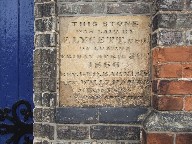| |
|
Lowestoft
Road Methodist Church, Gorleston-on-Sea This cheery
building sits at the top of Gorleston high Street, not
far from the more famous Catholic church by Eric Gill.
Methodism seems to have been a considerable enthusiasm of
the Gorlestoners, and the 19th century saw a great deal
of splintering and reforming among the three main strands
of Methodism. The banded brick hall to the north was an
earlier church, built in 1865 for Gorleston Wesleyan
Methodist Society as Lowestoft Road Chapel. It was paid
for by a wealthy London Methodist called Francis Lycett,
who gave £6,000 (just over a million in today's money)
for the construction of Wesleyan Methodist churches in
the Yarmouth area. £500 (£100,000 today) went to the
construction of this chapel, and you can still see
Lycett's name on the foundation stone. The architect was
a Mr J Bottle.
| The
rather more splendid and extravagant replacement
church opened in 1899, to the designs of William
Cockerill, the Great Yarmouth borough architect.
It is fully of its decade, and a reminder of how
non-conformism had fully embraced the Gothic of
its Anglican cousins by the end of the century.
The material is principally carstone, with
freestone used for those extraordinary spirelets.
The two buildings make a handsomely odd couple. Inside, the
1899 church is light and clean, the blue carpet
matching the ceiling and otherwise an
overwhelming feel of polished wood. The great
treasure of the building predates it by more than
a century, for here is the pulpit used by the
great John Wesley himself when he preached at the
Rows Chapel in Great Yarmouth. The stained glass
behind the holy table, depicting Christ suffering
the children, is pleasant and not intrusive. All
in all, the interior is less spectacular than the
exterior, which is probably just as it should be.
|
|
 |
|
|
|
